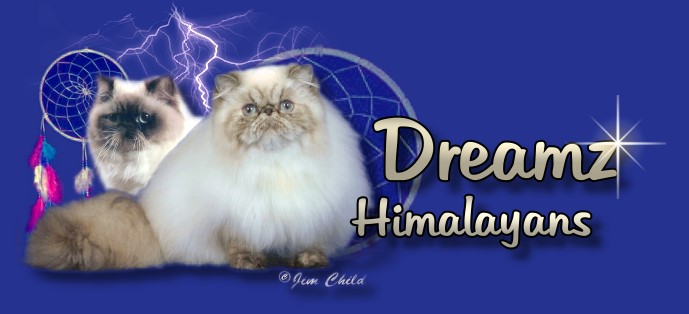


Français
PASSION OF GENETICS
We come to the fun part of cat breeding; genetics. Some find genetics hard to understand while others develop a great passion for genetics. No matter how you look at it, when dealing with or breeding plants and animals you need to know genetics on some level. The more you understand the better your success. To me, genetics is my passion, just as the cats themselves and my paintings are to me. Genetics puts a great deal of fun in the cat breeding game.
l'm not going into a great deal of depth on genetics; just a simple outline as to how they can be used in Chocolate/Lilac breeding. This will be in very simple terms so that anyone can follow. First, there are Dominant and Recessive Genes. An example is the gene for the color point pattern; this is Recessive and it's Dominant gene is color over the entire cat. Another example is the Recessive gene for Chocolate color, 'bb' and the Dominant gene, 'BB' for Black/Seal color.
Genes are always in pairs, so when one Dominant gene is present, this effects the trait. So if you have a cat that is Bb the color would show Seal, however this cat would also have the Recessive gene for Chocolate. In other words, this cat would be a Chocolate carrier, and if bred to another Carrier, or to a Chocolate/Lilac, you would get some Chocolates/Lilacs.
When breeding Chocolate and
Lilac pointed Himalayans, we are working with 2 Recessive
genes. One for point pattern, and the other for Chocolate/Lilac
color. You can see why working with Chocolates and Lilacs
is so difficult. And producing a show quality in these
colors are even more challenging. Any breeder producing a
show type in these colors is truely an artist in Genetics.
Another key for one to remember is that the gene pool is
very small for Chocolates/lilacs. All trace back to about
4 individuals that where first brought into the first
Himalayan breeding programs. One of the best ways to
succeed is to breed the best Chocolate and Lilac stock
you can to, the best Traditional Himalayan stock you can
find. This should give you some top Chocolate/Lilac
Carriers to work with. The rest would be your skill as a
breeder in selecting individuals that come closest to the
set down standards for the breed.
POSSIBLE GENE COMBINATIONS
A CPC which is a color point carrier comes from breeding a Pointed colored cat to a Nonpointed cat. When you breed 2 CPC's together you will get 50% CPC's, 25% would be pointed, and 25% would be Non Color Point Carriers. One must remember that there is a DNA test available through UC Davis Labs for CPC's. This will help to take out the guess work on the hidden Recessive gene, and indeed tell you if a kitten is a CPC.
A Visual Chocolate/Lilac breed to a Traditional Color will give you a litter of 100% kittens with Traditional colors but are Chocolate/Lilac Carriers. This is the best way in our opinion to produce show type Chocolate/Lilac Carriers.
Breeding a Chocolate/Lilac Carrier to a Chocolate/Lilac Carrier will give you the following, 50% Carriers, 25% Visuals Chocolate/lilac range, and 25% will be Non Carriers just Traditional colors and genes. At this point in time, UC Davis Labs doesn't have a DNA test for Chocolate/Lilac genes. This is coming shortly, please contact them and inform them of your interest in this test. This type of test will be a very useful tool in our breeding programs. It would enable us to keep individuals that actually have our Recessive gene for Chocolate/Lilac to use in our breeding programs.
When breeding a Chocolate/Lilac Visual to a Chocolate/Lilac Carrier, the offspring would be 50% Visuals and 50% Carriers. There is no guessing on this breeding.
Lets throw in Lynxs for a touch, this is where our breeding program really goes. Lynxs can have 2 gene structure either Aa or AA. Now if your lucky to have a Lynx point with the gene type AA, this is Dominate and all kittens from this cat will be Lynx points. An individual with AA can only come out of a mateing of 2 Lynx points. UC Davis Labs now have a test to determine if a Lynx is either AA or Aa. This test is a very useful tool in a Lynx breeding program. It also helps us to determine if a cat is actually a Lynx point or not, as some of the lighter color Lynxs can give a problem, such as Cream Lynx points. When you breed a Lynx to any color of Himalayan you will get about 50% Lynx points. Our goal is to one day have a Visual Chocolate/Lilac Lynx with the gene type AA. This is one of our dreams and goals.
Our hope and dream is that in some way we can help some breeders understand Chocolate/Lilac Genetics better; to enable more to produce top cats in this color range. We must all help one another on some level to better the breed and fancy as a whole.
LOVE & ON WITH THE DREAM, FROM DREAMZ CATTERY
News up date UC Davis labs now perfoms DNA color test for the Chocolate gene. Yes that's right there is no gessing now we have all the tools we need on hand. Now we can test for the Lynx gene, the Chocolate gene, and if a cat carriers the Color Point patteren gene. With all of this plus a great line to work with, and Cat Tracks for great info a breeder has all the finest tools on hand to develop a fine line.
| About us | | Studs | | Queens | | Available | | Past kittens | | Gallery | | At the show | |
©2005 Dreamz
Himalayans & Webdesign Passion Féline.
Exclusive copyrights, graphics and content. Forbidden
distribution and reproduction.
Photos on this site are the exclusive property of the respective
photographers.